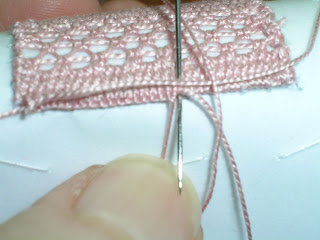Et voilà! Ora finiamo veramente il nostro primo quadrato di merletto!
Nel post precedente avevamo ultimato i punti di riempimento. Ora dobbiamo rifinire il contorno. in certi casi si lscia senza rifinitura, per esempio in alcuni particolari dell'Aemilia ars, ma di solito si rifinisce con un punto festone regolare, più o meno imbottito. Questa operazione si chiama cordonatura.
Iniziamo dall'angolo inferiore sinistro. Si può procedere is from left to right and from right to left, as you prefer. This champion
do minimal padding, with only two wires "flying" and proceed exactly as for the stitch carving. If you want to give more emphasis to the outline you can use several strands of padding. If you want Sare for example, 4-wire, double un'imbastitura should do (in return) on the boundary (again as in the notch). We pass yet another thread with overlock on this tack, then we proceed with the two loose wires as I explain below. The flying leads make uniform the boundary and can accommodate eventiuali irregularities arranged properly help give a nice shape and the corners round parts. I never tried to do the banner without padding, but I is not good, because in the show through the irregularities of contour points.
were saying: near the angle (a bit later, so it is easier to close) leans a bit of padding, it supports the tail of the wire that is used for the banner, in order to stop it, and it starts:
Here's (above) its first points, on the left you see the tail of the wire pad that, once properly fixed, we will pull (gently!) to the right, so to make it disappear below the points.
Now abbiamo ricoperto tutta la codina del filo del punto festone, che ci serviva da secondo filo di imbottitura; ne aggiungiamo quindi un altro, che appoggiamo sul lavoro lasciando la solita codina a destra.
Si fissa col festone, prendendo i due fili di imbottitura
E si procede; ora troviamo la codina del filo di imbottitura che sporge, ormai ben fissata dai punti festone
La possiamo tirare dolcemente, in modo da farla sparire. Si potrebbe anche tagliare, ma probabilmente rest of the small debris that may be visible, so the work is smooth.
arrive at the corner, where we work alcni stitch pointing in the same little hole, moving on the side of the vertical wires, guide wires that are called precisely because they help shape the work.
continue on the vertical side. As you can see, the items must be spaced evenly, not too close, otherwise the boundary becomes wavy, once detached from the card, and not too spaced wires guiding otherwise transpire. Proceed as if you were un contorno a maglia bassa, all'uncinetto, per capirci.
Continuando sul contorno, arriviamo al secondo lato verticale, e ora bisogna cambiare il filo. Si procede sempre come nell'intaglio.
Quando c'è ancora filo per fare alcuni punti, si taglia uno dei fili di imbottitura (non sempre è necessario, ma questi fili sono grossi, l'imbottitura con tre sarebbe troppo "cicciona") e si appoggia il filo della nuova gugliata come se fosse un filo di imbottitura. Si fissa con alcuni punti festone, e si tira in modo da far sparire la codina di sinistra:
At this point, remove the wire from the needle (this will become the second wire of padding) and inserting the needle with the spire new that we just stopped. He puts the needle to the right from wrong in the last horizontal rib stitch:
 |
| Here you can still see the tail of the wire, I pulled the first to make the point because the 'I had forgotten |
The change of the wire is barely perceptible, we can finish the outline.
arrived near the beginning del lavoro, cominciamo a tagliare uno dei due fili di imbottitura
Poi chiudiamo il lavoro entrando dl rovescio al diritto nella costina del primo punto
A questo punto il nostro quadratino è proprio finito, non ci resta che staccarlo dalla carta.
Giriamo il lavoro sul retro e tagliamo un po' di punti di imbastitura
Poi dividiamo i due foglietti di cartoncino e tagliamo i fili al loro interno, operazione molto più veloce che farlo sul retro, utile soprattutto per grandi lavori
Una volta tagliati tutti i fili, possiamo delicatamente staccare il merletto dalla carta. Ecco cosa otteniamo:
Questo è il rovescio. Un po' di peli superflui, vero? Ci vuole la pinzetta!
Con una pinzetta da sopracciglia, togliamo tutti i fili rimasti.
Ora il nostro merletto è proprio finito!
Ecco, un po' in ritardo, il PDF di the latter part of the tutorial.






















0 comments:
Post a Comment